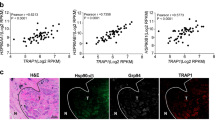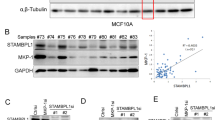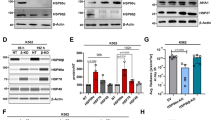Abstract
Ansamycins exert their effects by binding heat shock protein 90 (Hsp90) and targeting important signalling molecules for degradation via the proteasome pathway. We wanted to study the effect of geldanamycin (GA) and its derivative 17-allylamino-17-demethoxygeldanamycin (17-AAG) on glioblastoma cell lines. We show that these cells are growth inhibited by ansamycins by being arrested in G2/M and, subsequently, cells undergo apoptosis. The protein levels of cell division cycle 2 (cdc2) kinase and cell division cycle 25c (cdc25c) were downregulated upon GA and 17-AAG treatment and cdc2 kinase activity was inhibited. However, other proteins involved in the G2/M checkpoint were not affected. The cdc2 and cdc25c mRNA levels did not show significant differences upon ansamycin treatment, but the stability of cdc2 protein was reduced. The association of cdc2 and cdc25c with p50cdc37, an Hsp90 co-chaperone, decreased, but the interaction of cdc2 and cdc25c with the Hsp70 co-chaperone increased after ansamycin treatment. Proteasome inhibitors were able to rescue the cdc2 downregulation, but not the cdc25c reduction. However, calpain inhibitors were able to rescue the cdc25c downregulation, suggesting that cdc25c is proteolysed by calpains in the presence of ansamycins, and not by the proteasome. We conclude that ansamycins downregulate cdc2 and cdc25c by two different mechanisms.
This is a preview of subscription content, access via your institution
Access options
Subscribe to this journal
Receive 50 print issues and online access
$259.00 per year
only $5.18 per issue
Buy this article
- Purchase on Springer Link
- Instant access to full article PDF
Prices may be subject to local taxes which are calculated during checkout







Similar content being viewed by others
References
An WG, Schulte TW, Neckers LM . (2000). The heat shock protein 90 antagonist geldanamycin alters chaperone association with p210bcr-abl and v-src proteins before their degradation by the proteasome. Cell Growth Differ 11: 355–360.
Basso AD, Solit DB, Chiosis G, Giri B, Tsichlis P, Rosen N . (2002). Akt forms an intracellular complex with heat shock protein 90 (Hsp90) and Cdc37 and is destabilized by inhibitors of Hsp90 function. J Biol Chem 277: 39858–39866.
Bellocq A, Doublier S, Suberville S, Perez J, Escoubet B, Fouqueray B et al. (1999). Somatostatin increases glucocorticoid binding and signaling in macrophages by blocking the calpain-specific cleavage of Hsp 90. J Biol Chem 274: 36891–36896.
Blagosklonny MV, Toretsky J, Neckers L . (1995). Geldanamycin selectively destabilizes and conformationally alters mutated p53. Oncogene 11: 933–939.
da Rocha DS, Friedlos F, Light Y, Springer C, Workman P, Marais R . (2005). Activated B-RAF is an Hsp90 client protein that is targeted by the anticancer drug 17-allylamino-17-demethoxygeldanamycin. Cancer Res 65: 10686–10691.
de Cárcer G . (2004). Heat shock protein 90 regulates the metaphase-anaphase transition in a polo-like kinase-dependent manner. Cancer Res 64: 5106–5112.
Demidenko ZN, Vivo C, Halicka HD, Li CJ, Bhalla K, Broude EV et al. (2006). Pharmacological induction of Hsp70 protects apoptosis-prone cells from doxorubicin: comparison with caspase-inhibitor- and cycle-arrest-mediated cytoprotection. Cell Death Differ 13: 1434–1441.
Drysdale MJ, Brough PA, Massey A, Jensen MR, Schoepfer J . (2006). Targeting Hsp90 for the treatment of cancer. Curr Opin Drug Discov Devel 9: 483–495.
Georgakis GV, Li Y, Rassidakis GZ, Martinez-Valdez H, Medeiros LJ, Younes A . (2006a). Inhibition of heat shock protein 90 function by 17-allylamino-17-demethoxy-geldanamycin in Hodgkin's lymphoma cells down-regulates Akt kinase, dephosphorylates extracellular signal-regulated kinase, and induces cell cycle arrest and cell death. Clin Cancer Res 12: 584–590.
Georgakis GV, Li Y, Younes A . (2006b). The heat shock protein 90 inhibitor 17-AAG induces cell cycle arrest and apoptosis in mantle cell lymphoma cell lines by depleting cyclin D1, Akt, Bid and activating caspase 9. Br J Haematol 135: 68–71.
Grbovic OM, Basso AD, Sawai A, Ye Q, Friedlander P, Solit D et al. (2006). V600E B-Raf requires the Hsp90 chaperone for stability and is degraded in response to Hsp90 inhibitors. Proc Natl Acad Sci USA 103: 57–62.
Hostein I, Robertson D, DiStefano F, Workman P, Clarke PA . (2001). Inhibition of signal transduction by the Hsp90 inhibitor 17-allylamino-17-demethoxygeldanamycin results in cytostasis and apoptosis. Cancer Res 61: 4003–4009.
Kamal A, Boehm MF, Burrows FJ . (2004). Therapeutic and diagnostic implications of Hsp90 activation. Trends Mol Med 10: 283–290.
Kim HR, Lee CH, Choi YH, Kang HS, Kim HD . (1999). Geldanamycin induces cell cycle arrest in K562 erythroleukemic cells. IUBMB Life 48: 425–428.
McIlwrath AJ, Brunton VG, Brown R . (1996). Cell-cycle arrest and p53 accumulation induced by geldanamycin in human ovarian tumour cells. Cancer Chemother Pharmacol 37: 423–428.
Miller P, DiOrio C, Moyer M, Schnur RC, Bruskin A, Cullen W et al. (1994). Depletion of the erbB-2 gene product p185 by benzoquinoid ansamycins. Cancer Res 54: 2724–2730.
Munster PN, Marchion DC, Basso AD, Rosen N . (2002). Degradation of HER2 by ansamycins induces growth arrest and apoptosis in cells with HER2 overexpression via a HER3, phosphatidylinositol 3′-kinase-AKT-dependent pathway. Cancer Res 62: 3132–3137.
Neckers L . (2002). Hsp90 inhibitors as novel cancer chemotherapeutic agents. Trends Mol Med 8: S55–S61.
Nigg EA . (2001). Mitotic kinases as regulators of cell division and its checkpoints. Nat Rev Mol Cell Biol 2: 21–32.
Nomura M, Nomura N, Newcomb EW, Lukyanov Y, Tamasdan C, Zagzag D . (2004). Geldanamycin induces mitotic catastrophe and subsequent apoptosis in human glioma cells. J Cell Physiol 201: 374–384.
Schulte TW, Blagosklonny MV, Ingui C, Neckers L . (1995). Disruption of the Raf-1-Hsp90 molecular complex results in destabilization of Raf-1 and loss of Raf-1-Ras association. J Biol Chem 270: 24585–24588.
Senju M, Sueoka N, Sato A, Iwanaga K, Sakao Y, Tomimitsu S et al. (2006). Hsp90 inhibitors cause G2/M arrest associated with the reduction of Cdc25c and Cdc2 in lung cancer cell lines. J Cancer Res Clin Oncol 132: 150–158.
Sharp S, Workman P . (2006). Inhibitors of the HSP90 molecular chaperone: current status. Adv Cancer Res 95: 323–348.
Sorimachi H, Ishiura S, Suzuki K . (1997). Structure and physiological function of calpains. Biochem J 328 (Part 3): 721–732.
Srethapakdi M, Liu F, Tavorath R, Rosen N . (2000). Inhibition of Hsp90 function by ansamycins causes retinoblastoma gene product-dependent G1 arrest. Cancer Res 60: 3940–3946.
Stupp R, Hegi ME, van den Bent MJ, Mason WP, Weller M, Mirimanoff RO et al. (2006). Changing paradigms – an update on the multidisciplinary management of malignant glioma. Oncologist 11: 165–180.
Whitesell L, Mimnaugh EG, De Costa B, Myers CE, Neckers LM . (1994). Inhibition of heat shock protein HSP90-pp60v-src heteroprotein complex formation by benzoquinone ansamycins: essential role for stress proteins in oncogenic transformation. Proc Natl Acad Sci USA 91: 8324–8328.
Xiao L, Lu X, Ruden DM . (2006). Effectiveness of hsp90 inhibitors as anti-cancer drugs. Mini Rev Med Chem 6: 1137–1143.
Acknowledgements
We are grateful to our laboratory members for helpful comments. This article has been funded by Instituto de Salud Carlos III grant FIS PI041084 to I Martínez-Lacaci, and by a grant from the Fundación Mutua Madrileña de Automovilistas, Investigación Médica to I Martínez-Lacaci.
Author information
Authors and Affiliations
Corresponding author
Rights and permissions
About this article
Cite this article
García-Morales, P., Carrasco-García, E., Ruiz-Rico, P. et al. Inhibition of Hsp90 function by ansamycins causes downregulation of cdc2 and cdc25c and G2/M arrest in glioblastoma cell lines. Oncogene 26, 7185–7193 (2007). https://doi.org/10.1038/sj.onc.1210534
Received:
Revised:
Accepted:
Published:
Issue Date:
DOI: https://doi.org/10.1038/sj.onc.1210534
Keywords
This article is cited by
-
Advances in HSP27 and HSP90-targeting strategies for glioblastoma
Journal of Neuro-Oncology (2016)
-
17-DMAG induces heat shock protein 90 functional impairment in human bladder cancer cells: knocking down the hallmark traits of malignancy
Tumor Biology (2016)
-
A C-terminal HSP90 inhibitor restores glucocorticoid sensitivity and relieves a mouse allograft model of Cushing disease
Nature Medicine (2015)
-
Apoptosis of osteosarcoma cultures by the combination of the cyclin-dependent kinase inhibitor SCH727965 and a heat shock protein 90 inhibitor
Cell Death & Disease (2013)
-
17-Allylamino-17-demethoxygeldanamycin induces downregulation of critical Hsp90 protein clients and results in cell cycle arrest and apoptosis of human urinary bladder cancer cells
BMC Cancer (2010)



